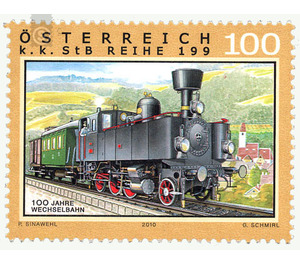100 years - Austria / II. Republic of Austria 2010 - 100 Euro Cent
Theme: Traffic, Transportation & Mobility
| Country | Austria / II. Republic of Austria |
| Issue Date | 2010 |
| Face Value | 100.00 |
| Edition Issued | 160,000 |
| Printing Type | combination printing |
| Stamp Type | Commemorative |
| Item Type | Stamp |
| Chronological Issue Number | 2229 |
| Chronological Chapter | OOS-OE2 |
| SID | 873483 |
| In 63 Wishlists | |
With the new special stamp "100 Jahre Wechselbahn" one of the most popular Austrian brand series ("railways") finds its attractive continuation; the design of the motif - it shows a historic locomotive from the k. k. StB Series 199 - comes from the well-known artist duo Peter Sinawehl (draft) and Prof. Gerhart Schmirl (engraving). The Wechselbahn, officially opened on October 12, 1910, connects the two towns Aspang-Markt in Lower Austria and Friedberg in Styria; It got its name, of course, because on its way under the powerful mountain range of the change with a nearly 2.5 km long Wasserscheidetunnel, which breaks through the large Hartberg, underfires. Between the waterways of the Taucher and the Pinkabachs, the high-field ridge is pierced by another, just over 1,200 meters long tunnel. The sum of the climbed heights from Aspang to Hartberg amounts to about 200 meters, in the opposite direction to 346 meters. The Wechselbahn connects the Aspangbahn with both the Thermenbahn (from Friedberg to Fehring) and the Pinkatalbahn (from Friedberg to Oberwart). The costly and extremely dangerous nature of the construction of this railway line is borne out by sad figures: 16 workers were killed during the arduous construction work in the years 1907-1910, and more than 1,600 people were seriously injured. Another example from the literally "dark past" of the Wechselbahn is, of course, the fact that the tunnels near Mönichkirchen served as the mobile leader's headquarters "Frühlingssturm" from 12 to 25 April 1941 as a place to direct the Balkan campaign. Since the beginning of 2005, the ÖBB 5022 ("Desiro") railcars of Siemens and VT 5047 have been used on the Wechselbahn line in passenger services for trains with locomotives - the majority of these are the so-called "City Shuttle trolleys". - but the series 2016 ("Herkules"). Freight trains are usually also covered with this type. Before that, ie until 2005, the VT 5047 and the VT 5147 and locomotives of the series 2043 and 2143 were driving on the line.


